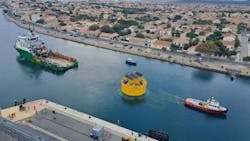Floating wind designs advancing on several fronts
Editor's note: This Renewable Energy column first appeared in the March-April 2024 issue of Offshore magazine. Click here to view the full issue.
By Bruce Beaubouef, Managing Editor
Offshore wind energy developers, engineers and construction companies are moving forward with designs for floating foundations as projects move into deeper waters. Plans for floating wind projects are advancing in the Atlantic offshore Spain, in the Mediterranean offshore France and Italy; and in Asia, offshore South Korea.
Most recently, Renantis and BlueFloat Energy have started the environmental impact assessment (EIA) process for Kailia Energia, their second floating offshore wind project.
The location is off the coastline of southeastern Italy between Brindisi and San Cataldo. Kailia Offshore involves the installation of up to 78 floating wind turbines with a projected capacity of 1,170 MW and production of about 3.4 billion kWh/year. The estimated overall cost is close to EU$4 billion ($4.36 billion).
Meanwhile, Bourbon Subsea Services says that it has completed installation of the foundations for the QAIR-led Eolmed pilot floating wind farm in the Mediterranean Sea offshore southern France. The Floating Electrical Hub (FEH) infrastructure offshore Port-la-Nouvelle will be connected to three wind turbines at the Eolmed site off Gruissan (which Bourbon is due to install by 2025) and the shore connection cable, enabling delivery of electricity to the local grid. The three wind turbines are expected to generate more than 110 million KwH/year.
For the initial program, completed last fall, Bourbon mobilized a team of engineering, project management and offshore technicians for the design, manufacture, towing and installation of the FEH and its subsea mooring system. Towing and installation, over a two-month period, involved the use of the Bourbon Liberty 222 anchor-handling tug supply vessel equipped with ROVs.
Eolmed, one of the first floating wind farm projects in the Mediterranean, is intended to validate the technical reliability of the installation and to support the creation of an offshore wind energy industry in the Occitanie and PACA regions of southern France.
Still elsewhere, developer X1 Wind reported successful results last fall from its PivotBuoy demonstration project near the Canary Islands offshore Spain. The PivotBuoy project was developed by X1 Wind in collaboration with nine industry and R&D leaders, and reportedly brought several important results. During the seven-month demonstration, the X30 platform became the world’s first fully functional floating wind tension leg platform. The unit fed its electricity to PLOCAN’s platform via a 1.4-km 20kV subsea cable. X1 Wind CEO Alex Raventos said that the results illustrated good performance across a broad range of parameters including platform stability, passive alignment, structural behavior and power production. These findings will in turn inform X1 Wind’s ongoing commercial-scale projects, including the NextFloat Project.
In Asia, Aker Solutions and Principle Power have been awarded a front-end engineering and design (FEED) contract for the floating foundations of the Haewoori Offshore Wind 2 and 3 projects off the coast of Ulsan, Korea. The projects are being developed by Copenhagen Infrastructure Partners.
As part of the scope, Aker Solutions will coordinate the design and delivery of the floating foundation structures required for the Haewoori Offshore Wind project and perform the front-end engineering design of the inter-array cable, marshaling port, wind turbine integration, and transport and installation.
Principle Power will work under subcontract to perform the design of the floating platforms and mooring system based on its WindFloat technology. Aker Solutions will also carry out execution planning, and work with Haewoori Offshore Wind to engage with the Korean supply chain to maximize local engagement in the projects. Work will start immediately on FEED and is due to be completed by November 2024.
About the Author
Bruce Beaubouef
Managing Editor
Bruce Beaubouef is Managing Editor for Offshore magazine. In that capacity, he plans and oversees content for the magazine; writes features on technologies and trends for the magazine; writes news updates for the website; creates and moderates topical webinars; and creates videos that focus on offshore oil and gas and renewable energies. Beaubouef has been in the oil and gas trade media for 25 years, starting out as Editor of Hart’s Pipeline Digest in 1998. From there, he went on to serve as Associate Editor for Pipe Line and Gas Industry for Gulf Publishing for four years before rejoining Hart Publications as Editor of PipeLine and Gas Technology in 2003. He joined Offshore magazine as Managing Editor in 2010, at that time owned by PennWell Corp. Beaubouef earned his Ph.D. at the University of Houston in 1997, and his dissertation was published in book form by Texas A&M University Press in September 2007 as The Strategic Petroleum Reserve: U.S. Energy Security and Oil Politics, 1975-2005.

